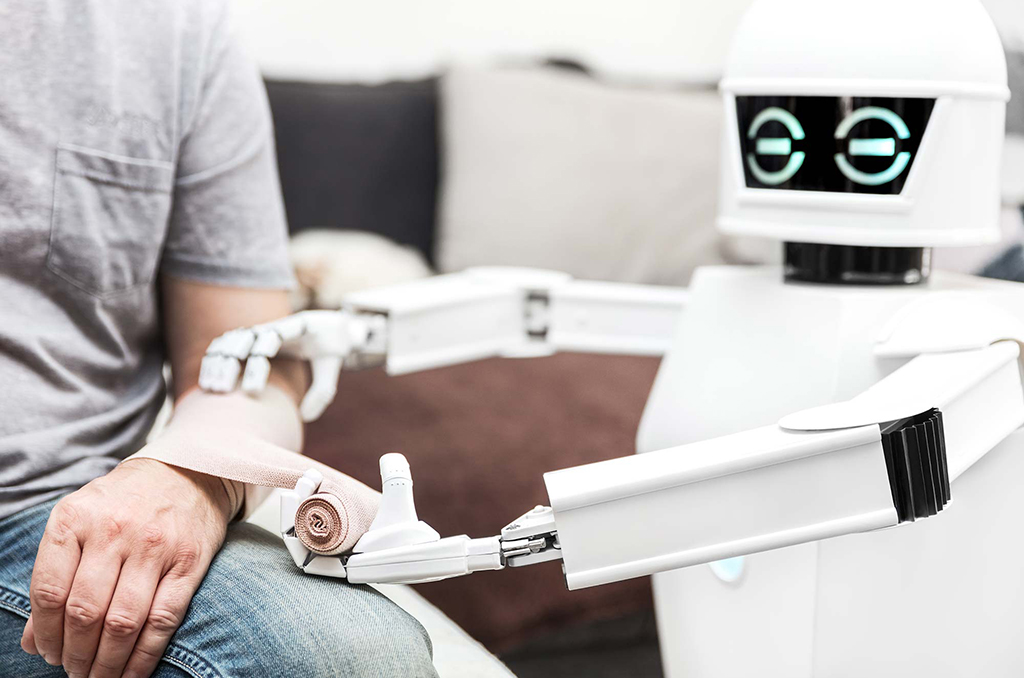Insight Paper February 14, 2019
Robotics in Healthcare
The impact of this generational disruptor.
Introduction
It is my opinion that Isaac Asimov has done us a disservice. Dr. Asimov led us through his many novels and stories to expect robots that could be police detectives, and guide humanity as they grow into a galactic empire spanning millennia.
The reality is, that we’re not quite there yet. We’ve learned from the overly exuberant expectations of Artificial Intelligence (AI) in the 20th Century that, well, machines have trouble thinking like we do—but maybe they don’t have to. In healthcare (for instance), robotics may be a hot technology whose time has come.
The reemergence this century of AI as machine learning (ML), deep learning (DL), and robotics is well named. “Robot” comes from the Czech word for “servitude”, and it’s best to think of robotics as rote executors of repetitive tasks. Although DL enables robotics to do quite complicated tasks, at the current state of the art, even small scenario changes require restarting the DL training from scratch.
This leads to our first tip:
![]()
WHILE THE FIELD OF ML/DL MAY BE DISRUPTIVE AND TRANSFORMATIVE, SUCCESS COMES FROM A SERIES OF SMALL STEPS, NOT A HUGE LEAP. YOU SHOULD START WITH A WELL-KNOWN CORNER OF YOUR OPERATIONS AND SET MODEST GOALS.
![]()
Recently, Trexin had a rash of phishing attacks over a period of two months. The main impact was good training for our employees on how to spot fake messages! But one unexpected benefit relates to our bot discussion here. A colleague decided to engage the phishing bot in an impromptu Turing Test, replying to the initial request (“please go get some stored value cards, and send me the numbers”) with “innocent” questions about how to deliver the cards, how to expense them, who can approve them, etc. After three exchanges, I noticed the sender quietly switched to another domain; the bot had “hooked a live one” but a human noticed that the bot was struggling and took over. This leads to our second tip:
![]()
LIKE HENRY FORD’S ASSEMBLY LINES LONG AGO, WITH SUPERVISORS CONTINUALLY OBSERVING THE WORKERS FROM UPPER-FLOOR WINDOWS, EVEN TRAINED BOTS NEED HUMAN SUPERVISION TO ENSURE THEY ARE ON TRACK AND TO INTERVENE IF NECESSARY.
Drivers
Robotics Process Automation (RPA) is particularly attractive to healthcare payers and providers, since there are many business processes which are rote enough to be good candidates for automation, but complicated enough to outstrip traditional workflow products—and HIPAA requirements limit offshore processing solutions. To be clear, this is not about displacing humans from their jobs; a full ts the opportunity for healthcare to focus on population health, value-based care and reimbursement, patient centricity, and improved compensation models.
Make money, save money, improve quality—these are drivers common across all business sectors. Via RPA we can also add the potential for improving satisfaction and engagement in the workforce.
A Modest Goal
This leads to our third tip:
A GOOD HEURISTIC TO IDENTIFY WHERE TO START WITH RPA IS TO FOCUS ON ACTIVITIES THAT CAPTURE AND MOVE DATA.
![]()
Two typical targets for RPA are customer care and claims processing. Let’s look at one Use Case, involving healthcare payers: the seemingly simple Member Service task of explaining to a member why a claim was denied. Again, a full treatment is worth its own discussion, but in short that answer today is the result of numerous internal research requests that bounce between many departments, well beyond the capability of conventional workflow products to resolve while the member waits for the answers to converge, if they do at all. In reality, Member Service spawns many instant messages and/or emails that bypass workflow in order to get that answer. But a bot could spawn many messages in parallel to other bots that research the pieces of the answer, and then assemble the responses into a final answer for the member.This implies a short, repeatable process to achieve our modest goal. We can leverage existing best practices and tools already in the enterprise:
- Document current business process(es) to understand what is going on.
- Prioritize automation opportunities according to the greatest benefit after the least effort.
- Apply technology to automate.
- Introduce robotics/ML/DL to enable the automation to adapt.

Tools That Can Help
This section is near the end, on purpose. Too often, people reach for the tool first, and believe the problem is solved if the tool is operating. That is as fallacious in RPA as it is everywhere else (one data center director, long ago, shared the secret to his revenue growth was that “we are happy to move our customers’ problems onto our servers for them”). Nevertheless, revisiting the short process in the previous section, here are some existing best practices/tools from other fields to leverage:
- Document current business process(es): truly just do a web search on “best tools to document process flows”, if you want your result in swim lanes or flow charts. If you want to be more creative, consider Issue Trees, fishbone diagramming, Cynefin.
- Prioritize: various Data Analytics, Value Stream Maps, Benefit & Effort Matrices, Theory of Constraints.
- Apply technology: varies by sector and function.
- Robotics/ML/DL: top RPA tools include BluePath, UiPath, and Automation Anywhere.
Parting Thought(s)
Robotics, in healthcare and elsewhere, may be one of the major disruptors in this generation. Regions and demographics across the globe will be impacted, and the target will be mid-skill workers rather than low-skill workers of previous generations.
People, being people, will react differently to this disruption—some embracing it, some resisting it, some frankly taking advantage of it. Regardless where you personally fall, Ellen Shell (Professor at Boston University) discussed the impact in an interview with Kara Swisher: this is an opportunity for the drivers, the passengers, and the displaced to pursue their passions. Don’t let it pass you by.


